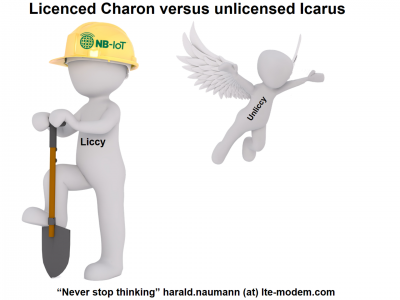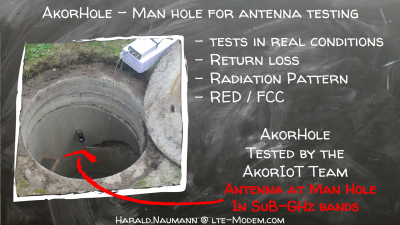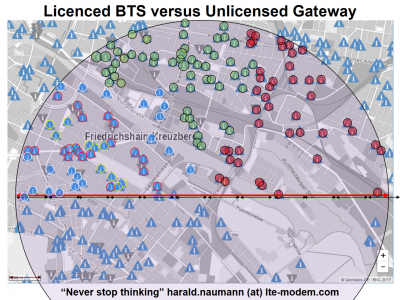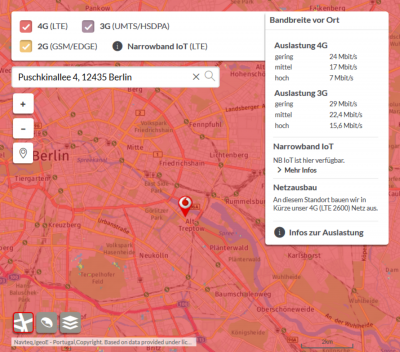Icarus wanted to go high up unlicensed. If you don’t follow the rules like Icarus, then the fall comes after the flight. Icarus melted the wings. Why do the unlicensed LPWA companies of all firms repeatedly report hot-air balloons or weather balloons with extreme ranges and fly towards the sky and the sun? Up there towards the earth’s atmosphere, there are not so many customers and projects. The life takes place on the ground. A proverb says “The streets are paved with gold”. Let’s get back to the ground of facts.
The electricity, water, and gas meters are in Germany in the basement and thus in the underground. Dogs and cats do not fly around and canaries are rarely located. Our aging society moves on foot or in a wheelchair and so far wheelchairs have no jet propulsion. Plants grow with roots in the soil. Vehicles move on roads and railways in cities often travel underground.
In the licensed frequency range you do not fly to the sun like Icarus, but climb down into the underworld. In the modern world, access to the underworld is via manholes. Such manholes are often monitored for water levels. The Styx River does not flow there, but the wastewater of our society does.
In order to achieve a perfect result, we in the akorIoT team proceed logically-mathematically and divide each task into subsets. One of the most important subsets in every LPWA project is the antenna. When you fly in the sky, the radio wave is limited only by the curvature of the earth. The higher you fly, the further you can transmit. The higher you fly, the lower you can fall. If you stick to the physical rules, then you are on the safe side. Therefore, we do not simply send from the manhole, but we measure the antennas in the manhole and check whether the return loss of the antenna in the manhole and with concrete and soil in the nearby area still agrees with the data sheet.
If the antennas still meet the specification, there is almost nothing to stop them from being transmitted from underground. As soon as the radio wave is out of the manhole, it only has to overcome the walls of the buildings to arrive at the finish of an LPWA antenna mast. Icarus could see far over the country. The ferryman Charon in the underground can’t see the sun and even if he comes to the edge of the manhole, in a big city like Berlin he will only see the walls of buildings. The direct view to the sun or to the LPWA tower is impossible for Charon.
The same will happen to the LPWA radio wave in our state capital Berlin. Berlin has an area of 892 km2. With only 36 LPWA mast each antenna must supply approx. 25 km2. That means approx. 2.9 km radius per cell. The pictures illustrate how 25 km2 (big circle) in the unlicensed band in Berlin look compared to the cellular base stations. Each blue triangle represents one cellular base station. We have three network operators in Germany. The dots in three colors (red, blue, green) around the triangles symbolize the three network operators. Probably the two large operators have more antenna towers than the smaller operator. In the diagram, we divide them into equal parts. The result shows the clear majority of licensed network operators. Each of the licensed NB-IoT operators owns at least 50 sites in Berlin. In Dresden, an NB-IoT cell in 2017 had an average size of 4.7 km2 and thus a radius of only 1.2 km. If just 10% of the sites will run on NB-IoT then we talk about 10% for Deutsche Telekom and 10% for Vodafone. In summary, it is estimated 60 NB-IoT BTS against one in the unlicensed band.
The Olympic LPWA championship in Berlin was won by NB-IoT. Place one and two are taken by NB-IoT. The map of Vodafone clearly shows that NB-IoT is ahead in Berlin. If you want to know exactly, you can order an NB-IoT scanner for 149 Euro from the akorIoT team. In addition to the NB-IoT-GPRS-LTEM module, a GNSS module and an ATMEL SAM21D are equipped with Arduino SDK plus many sensors. With the new akorIoT board you can scan NB-IoT, GPRS, and LTEM worldwide. A single PCB in the licensed band for all five continents and no regional zones and radio modules as in the unlicensed band. However, the open software interfaces with Arduino SDK and free C compiler can do much more than just a simple NB-IoT scanner. More about this later.
Has this article piqued your interest? Do you plan to deploy LPWA devices with embedded antennas? Do you have an IoT prototype and need to optimise the design or minimise the price? If you have answered YES to any one of these questions then please do not hesitate to drop an email to harald.naumann (at) lte-modem.com and to ask for a proposal or some engineering services to make your IoT idea a cost-effective reality.



